Subscribe
Get weekly recipe updates
sent to your inbox!


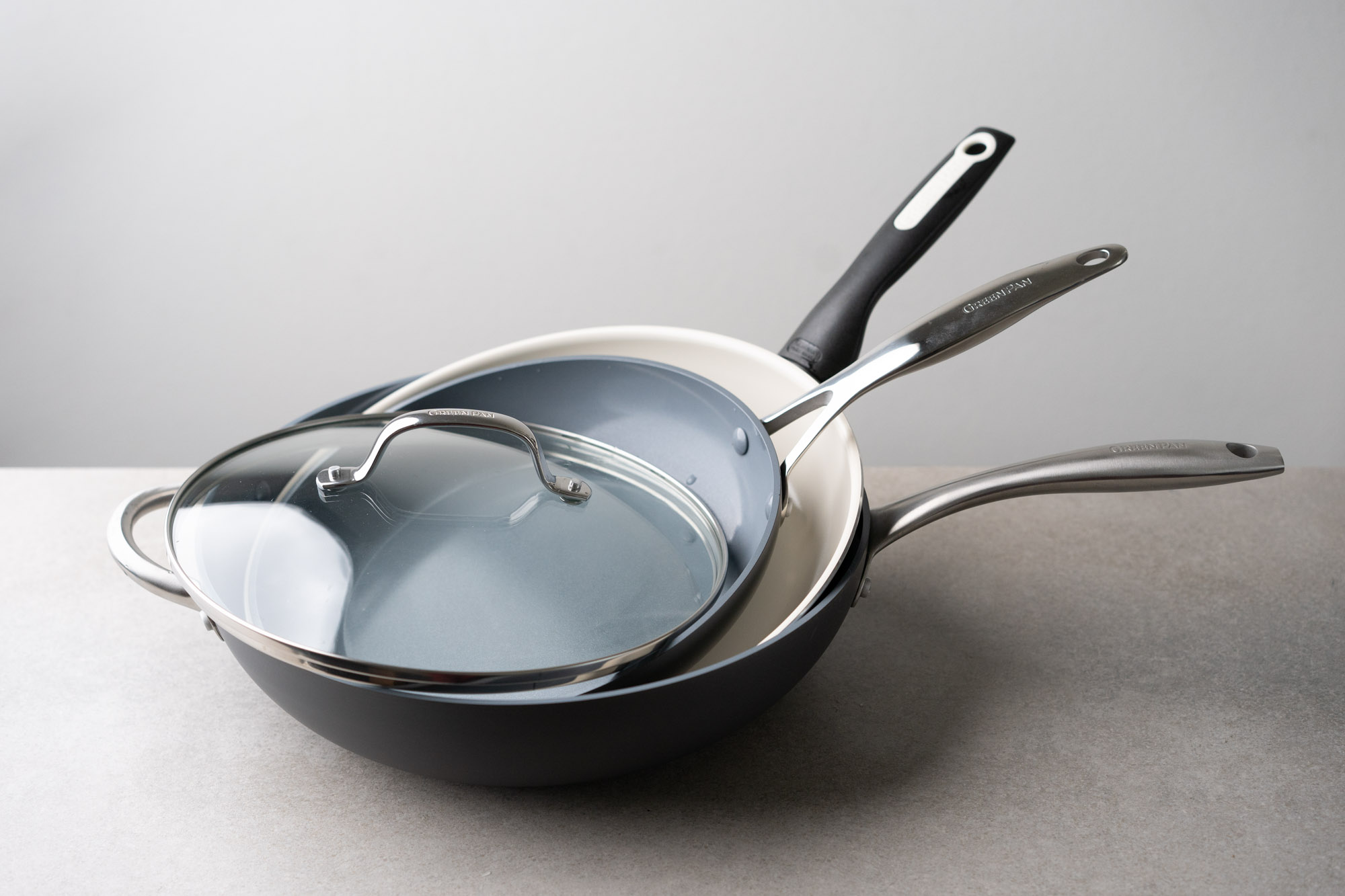
GreenPan has its share of admirers and detractors. For people who love the GreenPan, it’s non-toxic, nonstick cookware that’s 100% free of harmful chemicals that can leach into our bodies. Then, there are other people who believe that GreenPan’s claim that it’s the healthier cookware is a scam. However, GreenPan is pretty much loved globally for its unique ceramic non-Teflon coating and solid construction.
So to see if the hype was real, I tested GreenPan's 12" Rio fry pan, 10" Valencia Pro fry pan with lid, and GreenPan's 12.5" Lima wok to see how its nonstick coating performed, how cooking was and how the cleanup process was.
In 2007, the Belgian firm, The Cookware Company, introduced GreenPan as the first PTFE-free, nonstick cookware. Touting its revolutionary Thermolon ceramic coating as a new option for healthy cooking, GreenPan became a sensation when it was demonstrated by Chef Todd English on Home Shopping Network, selling 20,000 units of a six-piece set in four hours.
PTFE (polytetrafluoroethylene) – or the brand name Teflon – was made with perfluorooctanoic acid (PFOA), a toxic chemical that our bodies absorb and can lead to serious health conditions, including cancerous tumors. Up until 2013, all nonstick pans were made with PFOA, but by the end of 2015, the eight U.S. manufacturers of nonstick cookware ceased using PFOA in production.
In effect, back in 2007, GreenPan really was the first, purportedly safe nonstick cookware. Since then, though, The Cookware Company’s proprietary Thermolon coating has been under a lot of scrutiny and investigation. The company has been pretty cagy about Thermolon, claiming that it’s mostly made from silicon dioxide or silica, a natural compound that’s considered safe to humans.
In 2019, a class action lawsuit was filed against The Cookware Company for overhyping GreenPan’s health benefits and misrepresenting GreenPan as free of toxins. Thermolon’s patent shows that its formulation does indeed have minute amounts of chemicals that are toxic. In 2020, the lawsuit was dismissed with prejudice, meaning The Cookware Company can’t be prosecuted again on this charge.
Interestingly, one of the points of false advertising that the lawsuit brought up was The Cookware Company’s claim that the GreenPan was “diamond-enhanced.” The packaging of the 12-inch frypan that I bought still has “diamond-enhanced” in bold letters alongside a pictogram of a diamond. But is it really?
GreenPan is readily available pretty much everywhere, and there are several different collections. In 2021, Bobby Flay signed on to hawk GreenPan Premiere, and in promotional materials, Flay crows about its “Diamond-Advanced (notice the word change) Technology.”
The Cookware Company’s office is in Belgium, which is where all of its products are designed. GreenPan’s Thermolon coating is made in South Korea, and the cookware is manufactured in the company’s factory in Jiangmen, China.
On the GreenPan website, the company insists it has full control over manufacturing practices and procedures and ensures that the factory is environmentally friendly and sustainable. They also go out of their way to reassure customers that there is no child labor in their factory.
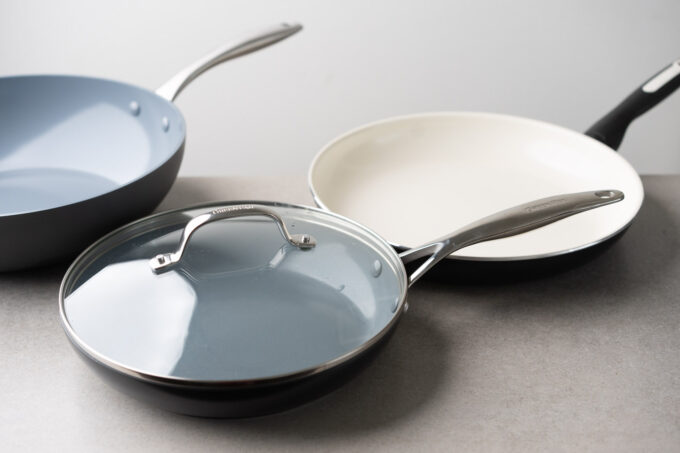
GreenPan has many cookware collections in different colors, styles, and metal-type.
The following collections are the same as Performance Pro but come in different colors and handle styles:
GreenPan also has a variety of other cookware and small appliances:
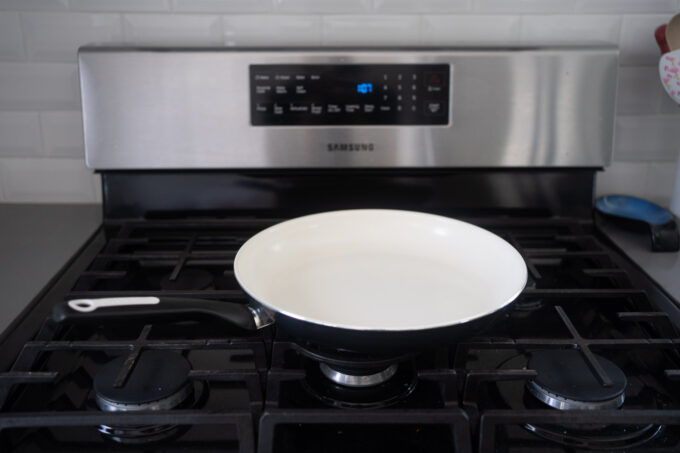
I tested the 12’ fry pan from the Rio Black collection and was very pleased with the results. The fry pan weighs 2 pounds, 3 ounces and felt substantial in my hand without being too heavy to shift on the stovetop or lift.
Unlike other nonstick pans I’ve tested, the Greenpan fry pan was completely flat, so liquid ingredients and eggs didn’t pool into the sides of the pan. It has an 8” handle that tapers to an oven-safe Bakelite grip and stays cool-to-the-touch when using the pan on the stovetop. The handle could be slightly longer to better support the weight of the pan.
The Rio collection comes in three colors: black, red, and sea-foam green. The interior of the pans is cream-colored and makes a nice two-tone contrast with the exteriors. The Rio Black cookware is elegant and snazzy and perfect for a modern kitchen. The red and sea-foam green pans are Martha Stewart-ish and would make a bold contrast on a black or white cooktop.

I cooked three different recipes in the fry pan: a Moroccan chicken sauté, a Spanish tortilla, and fried eggs.
GreenPan advises heating the pan at low to medium-low to prolong the Thermolon coating’s life. Other nonstick pans I’ve tested took 5 to 10 minutes to heat up, but the GreenPan heated evenly and fully in about 2 minutes. I used only 1 tablespoon of olive oil to sauté the aromatic vegetables, then added the sliced chicken. I kept the heat at medium low, and although the chicken didn’t brown, it did cook to a pale golden. I added wine, turned up the heat to evaporate the alcohol, and the dish was done, all in 10 minutes, and nothing stuck to the pan.
As to clean-up, GreenPan advises to let the pan cool, then simply wipe it clean with warm soapy water and a sponge. I actually could have just wiped it with a paper towel; the fry pan was that easy to clean. After a quick rinse, the interior and exterior looked like new.
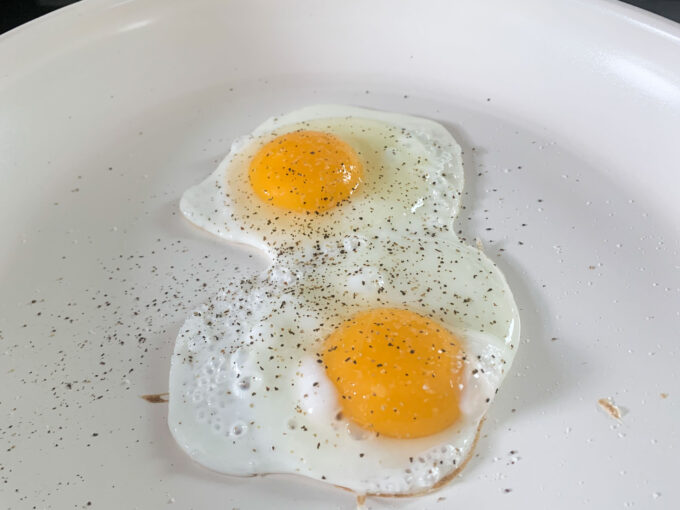
The Spanish tortilla is a simple recipe of sautéing onions and sliced potatoes in 2 tablespoons of olive oil, then pouring an egg mixture on top. Again, the fry pan heated evenly, so I didn’t need to move anything from the sides to the center to cook.
The GreenPan is broiler-friendly, and once the tortilla’s top had been browned, I slid the whole thing onto a cutting board without a spatula or even touching it. Once again, cleanup took less than a minute.
Frying eggs without butter or oil is always the supreme test for a nonstick pan. I cracked the eggs into the center, and when they were done to my liking, I just shook the pan, and yes, the eggs slid free. I then did a Julia Child flip for over easy eggs, and voila, they slid onto the waiting plate.
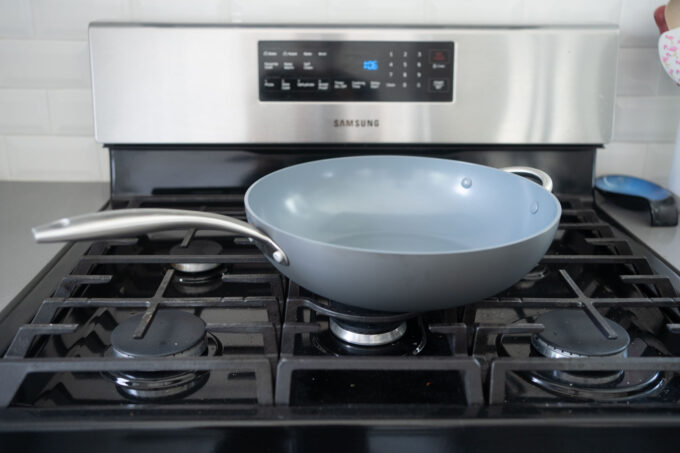
The 12.5” wok is from the Lima collection (there are 5 woks to choose from). It measures 12.5” in diameter at the top then narrows down to an 8” cooking surface. The wok is 4” deep and has an 8” handle that’s riveted through the pan. It weighs 2 pounds, 13 ounces and, like the fry pan, feels weighty but not heavy. The brushed aluminum handle is curved to fit ergonomically in hand.
Pots and pans in the Lima collection have dark gray exteriors and interiors that are slightly less gray. This is the type of cookware that you’ll see in many modern, updated kitchens and could be displayed on the cooktop or hung on a rack.
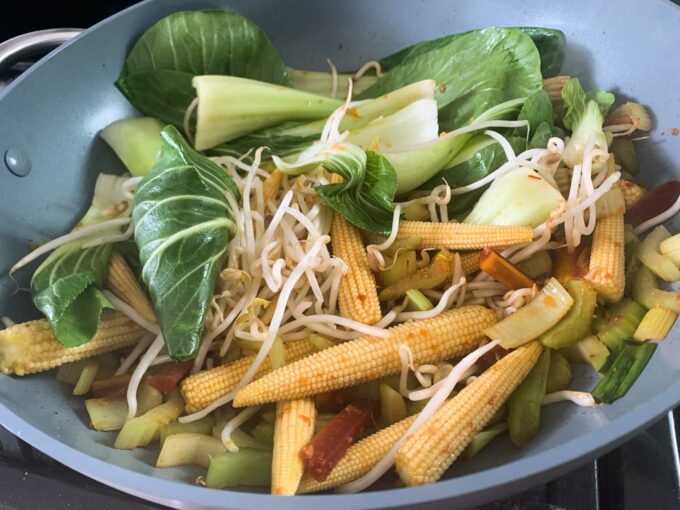
The GreenPan wok is made of anodized aluminum and has a slightly thicker construction than the Rio fry pan, which may be why it took longer to preheat. The sides were noticeably not as hot as the center of the wok. I added a tablespoon of oil, and then added the vegetables for a stir fry.
I moved everything continually with tongs, and the vegetables cooked evenly under medium heat. As with the fry pan, the stir fry slid onto a plate without sticking. Once cooled, the wok cleaned up in seconds and showed no signs of scratching.
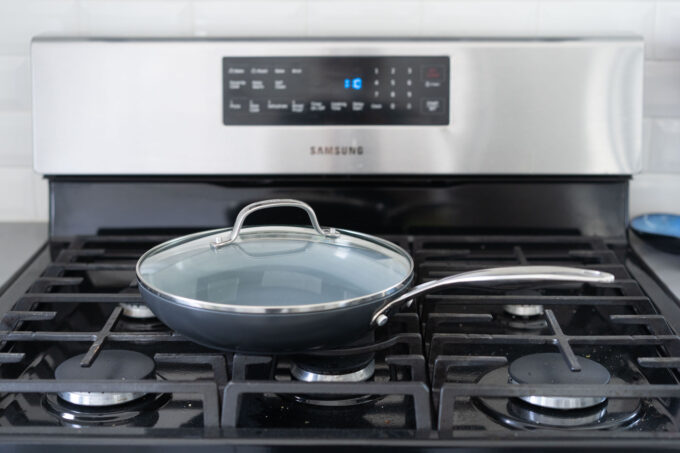
I also tested the 10” fry pan from the Valencia Pro collection, which is notable because it’s made for any heat source but was designed specifically for induction cooktops. The Valencia collection is GreenPan’s most awarded and popular because of its patented “Magneto 2” induction technology.
Induction cooktops need cookware that’s a magnetic metal. According to GreenPan’s website, the “Magneto” in the Valencia collection is a thick base that’s made of copper-reinforce magnetic iron particles. It has a slight pebbly finish, like a well-seasoned cast-iron skillet.
The Valencia Pro collection is similar in appearance (gray-on-gray) to the Lima collection, but its 8” handle is a striking polished aluminum. The handle is riveted through the pan and has a slight curve. It fit nicely in my hand, and I found the 2 pound pan easy to hold and move around my cooktop.
The pan’s weight and design was perfect for flipping eggs or an omelet. A tempered-glass lid is included, and it’s pretty identical to other glass lids that come with anodized cookware.
I had the same excellent results with the 10” fry pan as I did with the 12” and the wok. There was one noticeable difference. The Magneto base took quite a while to heat up, even longer than the wok. I maintained the flame at medium, and the bottom of the pan heated quicker than the sides. But after 5 minutes, the pan had fully heated and retained the heat very well.
This collection is also metal-utensil resistant, so it was a relief to move food around with a fork or spatula and not worry about scratching the nonstick surface.
If you push the hype to one side and look at GreenPan as a company, there’s a lot to admire. The factory is located in China, which, for some people, is cause to suspect manufacturing processes and quality control.
But GreenPan has gone to great lengths – more than a lot of American companies – to ensure high quality and sustainability. The factory is at present 30% solar powered, has an in-house wastewater management system, diminished carbon dioxide emissions, and uses recycled aluminum.
Whether or not you believe GreenPan is a healthier nonstick pan, the fact remains that its non-PFTE Thermolon coating is free of PFOA, lead, or cadmium. Add to this that GreenPan’s products are well-made, affordable, and internationally popular, it’s likely that the brand will be around a long while.
GreenPan has cookware collections for any budget, some of which are less expensive than GreenPan’s new competitor, Caraway, which I’ve also reviewed. You can pick up an 18-piece cookware set from the Lima collection for only $300 or the 22-piece set from the Rio collection for less than $350. Greenpan also has a painter’s palette of colors to choose from that will coordinate with any kitchen design.
Performance-wise, I had no complaints with the three GreenPans that I tested and would gladly toss out my old nonstick pans (well, maybe not my carbon steel) and replace them with GreenPan. Some Amazon naysayers gripe that the Thermolon coating doesn’t last, but who knows how they’ve treated or misused their pans? I say just follow the easy rules for all nonstick cookware, and the GreenPan will reward your small effort.